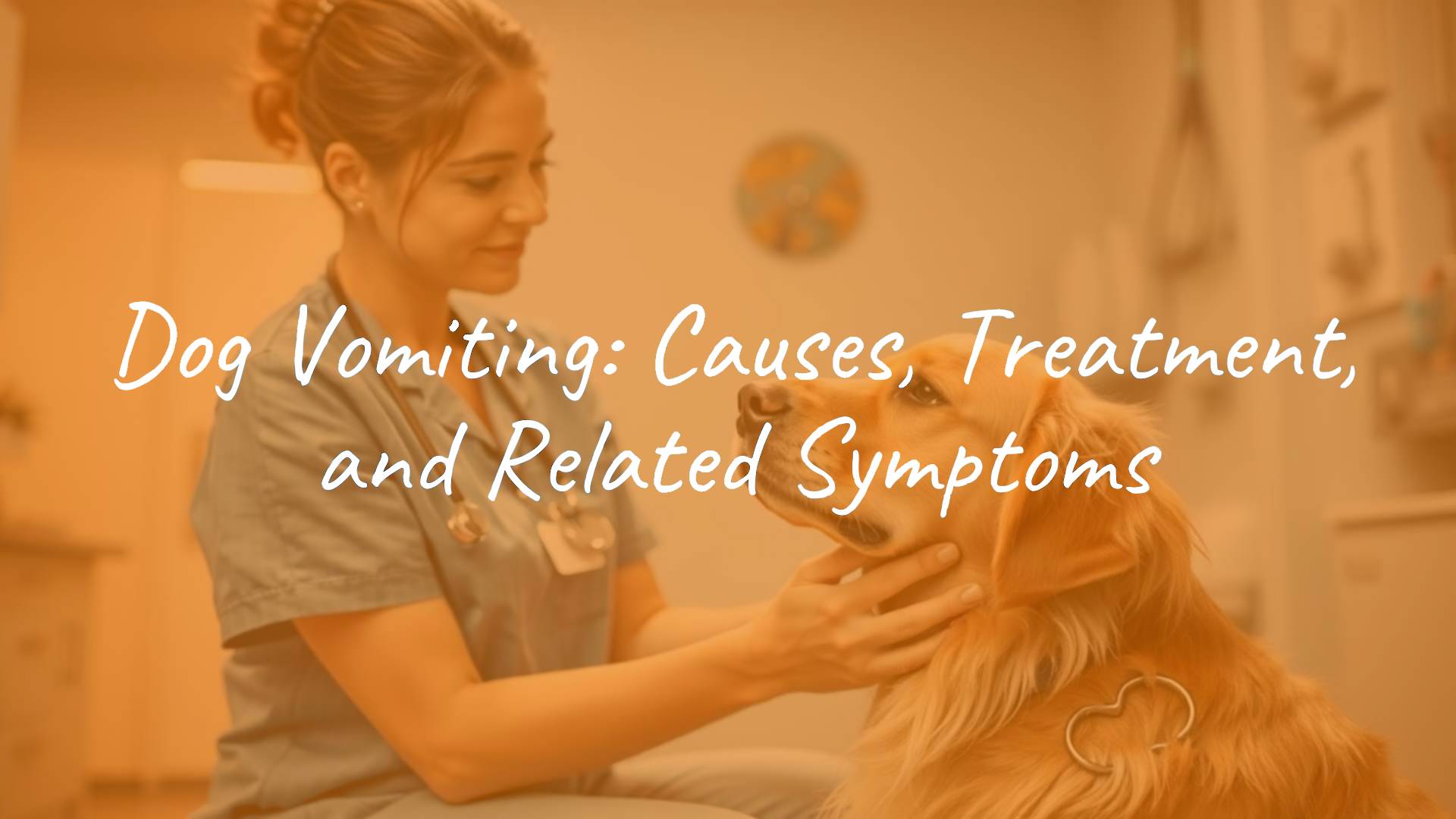
Vomiting in a dog, i.e., a common disease symptom not only characteristic of gastrointestinal diseases.
Any aware and responsible dog owner would no doubt want his animal to remain in the best condition, health, and best of all his life, and never get seriously ill.
This otherwise correct assumption is served by properly carried out prophylaxis, check-ups, maintenance, and nutrition. That is to say, in a nutshell, all activities that contribute to the responsible preservation of your animal. The attentive and concerned owner carefully observes the dog being cared for and reacts in the situation of even the smallest, worrying symptoms. In many cases, rapid intervention allows you to recognize the disease in advance and, thanks to the therapy, shorten the return to full health and vitality. Despite our highest attention and care, we must be sure that we will have to face our pets sooner or later.
Not all of them must immediately mean serious illness and pathology, which should not put our vigilance to sleep and give birth to thinking that it will pass by itself. In some cases, self-healing occurs, but many are, however, a prelude to much more serious pathologies and even an immediate threat to life.
The vigilant owner will always ask for help even in a seemingly harmless situation without fear of ridicule or accusation of a kind of exaggeration and oversensitivity. Let’s remember that today’s domestic, often purebred dogs do not have much in common with their wild ancestors hunting and eating what can be caught. Therefore, they remain more sensitive and show gastrointestinal symptoms much more often. A classic example of what I’m writing about is everyone’s well-known vomiting symptom in a dog. In the article, I will try to introduce you to the issue of vomiting in dogs, and sensitize everyone to what to do if they occur.
What is vomiting?
Vomiting (Latin emesis, vomitus) is defined as a multi-phase active, controlled by the nervous system reflex gastric emptying reflex, which stands out significantly from the return of food (Latin regurgitatio) which is a passive retrograde discharge of the esophagus.
The return of food is instead a manifestation of disorders in the process of swallowing food and occurs with esophageal diseases such as obstruction or paralysis.
I write about it because at the beginning, you should distinguish vomiting from returning food, which will allow you to know exactly what we are talking about.
Most people, moreover, can quickly determine if their dog is vomiting, but let’s systematize these two phenomena.
Return of food
In the process of returning food, the dogs leave the head and front part of the body leaning on the elbows and the esophagus under the influence of gravity empties passively, that is what lies behind it is excreted outside through the mouth.
The food expelled in this way, which, after all, has not managed to reach the stomach, is characterized by:
-
- neutral pH
- is covered with foam, mucus, or saliva
In theory, all this seems simple, although, in practice, it is not always the case. It may happen that the contents of the stomach will also have a neutral pH and have a foamy appearance, and the esophagus returns the content with the acid content that it found during reflux.
Vomiting
Vomiting is an active, multi-phase process consisting of three successive and firmly connected, consecutive stages.
Nausea
They start with a phase of nausea and anxiety, i.e., nausea manifested in:
- licking your lips
- excessive salivation
- attempts to swallow
- fearful movement or a kind of fear of the animal
In parallel, intestinal spasms, often visible to the owner himself, move the nutrient content to the already relaxed stomach.
Throttling
Then comes the choking phase of closing the pylorus and spasm of the abdominal muscles.
We will observe rhythmic, synchronized contractions of the abdominal muscles and the stomach itself, which is accompanied by deep breathing and choking followed with the naked eye.
Emptying the stomach
In the last phase, the stomach contents are emptied, i.e., we observe the ejection of acidic and partly already treated food enzymes with low pH content.
If vomiting content predominates in the vomit, the vomit will have a yellowish color resulting from the bile present there and rather neutral rather than acid reaction. We talk about chronic vomiting when they last more than three weeks, and by the acute condition, we mean suddenly occurring and lasting several days of vomiting. Although vomiting is an unfavorable phenomenon from the owner’s point of view and the reason for consultation in the veterinary office, they certainly play a defensive role in the body. Vomiting protects the body against the effects of toxic, inappropriate, inedible substances that have been taken or spoiled foods. By removing them outside in the act of vomiting, substances that may harm the dog are not absorbed into the bloodstream.
Let’s remember that the digestive process is a complex set of various chemical reactions involving enzymes and essential internal organs (e.g., liver, pancreas), and therefore, they have to do tough work. Vomiting relieves the digestive tract from excessive activity caused by too much food or its components. The body removes what is in its digestive tract and what cannot be digested and used to build its tissues. We cannot assess vomiting in any case as a pathology caused by gastrointestinal disease. In a bitch feeding a brood, an entirely physiological phenomenon is vomiting with digested food, which is used to feed the brood.
Such vomiting is a kind of natural phenomenon present in Canidae for thousands of years, and we absolutely can not treat them as pathology. Persistent vomiting in the case of diseases certainly requires prompt diagnosis and intervention because they can cause many health problems, which is a bit further.
Why does the dog vomit?
As I wrote, vomiting is a reflex controlled by the nervous system.
They are driven by emetic centers located in the reticular formation (formatio reticularis) of the brainstem.
They are a kind of command center coordinating the entire process of vomiting and ensuring its safe conduct. It is these parts of the brain that stimulate vomiting triggers, which are diverted to target organs through efferent or efferent pathways. At the same time, not only the organs of the gastrointestinal tract but also other systems indirectly involved in the act of vomiting, such as the respiratory system, act out the right signal for action. The stimuli that reach the emetic center come from various areas of the body.
In general, however, we can distinguish those from:
from the vestibular apparatus, i.e., the organs responsible for maintaining balance, from the nervous system superior to the medulla oblongata where the vomiting center lies, i.e. from the cerebral cortex, hypothalamus or limbic system.
- From the chemoreceptor zone located in the fourth ventricle of the brain
- from the abdominal organs
- from the chest organs
- from the upper respiratory tract or throat
So we see that vomiting does not always have to have a direct cause in the gastrointestinal tract, although, by many, they are associated only with diseases of this system.
Vomiting can be initiated by emetic stimuli that stimulate receptors located in the abdominal cavity, i.e., the viscera and peritoneum.
All inflammatory processes taking place in the peritoneal cavity or even the pancreas, liver, stomach, or kidneys may be the reason for the stimulation of receptors and the initiation of vomiting reflex. All toxins, osmotic substances, or chemical agents interacting in the gastrointestinal tract will have similar effects.
Stimuli, i.e., forces acting on the mesentery and stretching them, as well as spasms of cavernous organs (intestine, bladder, stomach), will also trigger vomiting.
Interestingly, receptors whose stimulation causes vomiting also occur in the heart. All this information in the form of nerve impulses reaches from the abdomen and chest to the vomiting center through the vagus nerve and sympathetic nervous system. A significant triggering center is the chemoreceptor zone located outside the blood-brain barrier. Often, various substances from various organs (e.g., urea, creatinine, bilirubin, ammonia) present in the blood and body fluids, drugs (anticancer drugs, apomorphine) stimulate the nerve endings of this zone, which leads to vomiting. The stimuli captured by the chemoreceptor zone are processed and sent directly to the emetic center.
In this process, neurotransmitters play a huge role, i.e., mainly:
- serotonin,
- noradrenaline,
- dopamine,
- histamine,
- acetylcholine
Many substances cause vomiting directly through irritation of the gastric or intestinal mucosa. It is impossible to list here all substances having such an effect.
Nevertheless, this path is understood by many as a classic that causes vomiting from the gastrointestinal tract. This can be, for example, broken, rotten, stale food containing bacteria, or any ingredients that get into the stomach and intestines with food taken and are not tolerated by the dog. Vomiting can come from the stimulation of the vestibular apparatus by sudden and rapid movements, which may be a classic book example of motion sickness. Vomiting caused by triggering stimuli originating from the supernova areas of the brain, i.e., the cerebral cortex or limbic system, are most often caused by emotional states in stress, anxiety, and escape. They may be a consequence of disease processes affecting the central nervous system in which there is an increase in intracranial pressure (injuries, accidents, bleeding within the brain). Vomiting can also occur at high temperatures and thus accompany a fever and any pain processes.
We should know that if the vomiting comes from the limbic system, we call it central vomiting.
The consequences of vomiting in a dog
Vomiting, like the one I described earlier in my last article, diarrhea in a dog is a disease symptom informing us of abnormalities taking place in the body.
And although it sounds very general, it is sometimes difficult to unequivocally determine their immediate cause at the first visit.
They are a non-specific symptom that we can attribute to many different diseases. They do not always mean serious pathology, which, of course, should not diminish our vigilance and cause them to be underestimated for a simple reason. First, they can mean some pathology, inflammation that requires treatment. They can cause pain and discomfort felt by the animal. Secondly, persistent longer disturbs the body’s water management in extreme cases leading to significant dehydration with all life-threatening consequences. They not only cause dehydration but also disrupt the acid-base balance and get rid of valuable electrolytes (e.g., calcium or potassium). A significant deficiency of the latter will lead to serious arrhythmias. Dehydration of the body is a very dangerous pathology leading to a disturbance of homeostasis and hypovolemic shock, which sometimes can even end in a lethal descent. It progresses faster in younger animals, puppies, with lower body weight and can never be underestimated. Younger individuals contain more water in their bodies, and hence potential dehydration is more dangerous for them. All organs remain less well-nourished and oxidized, urine production decreases, kidneys may become inefficient, and liver detoxification abilities decrease. During vomiting, vomit may get aspirated and enter the lungs, which will immediately result in apiration pneumonia, often ending in the dog’s death.
Often, the vomiting dog experiences anorexia, refuses to eat or drink, which leads to weakness and further dehydration. Longer lasting ones may even lead to cachexia, i.e., clinically apparent emaciation. All this causes a worse course of the primary disease at which vomiting occurs and complicates further treatment, not to mention the prognosis. The acid reflux from the stomach can irritate the lumen of the esophagus, causing inflammation.
What does the dog vomit?

Vomited content or something that we colloquially refer to as vomit may look very different, which undoubtedly provides precious information about the place where this material comes from. Let’s follow what really can vomit our ward to provide this data to the doctor later faster and more effectively to get appropriate help. These seemingly insignificant data provide essential information about the vomiting itself.
And so going to the details.The dog vomits foam. Vomiting foam in a dog is excretion, coughing up saliva, and most likely testify to a throat disease.
So they can occur at:
- sore throat
- palatine tonsil diseases or human angina.
The ongoing inflammatory process often caused by microorganisms irritates the mucosa of this gastrointestinal tract, which results in an attempt to cough or cough and expel salivary secretions or foam. This reflex is not accompanied by abdominal muscle work and excretion of the digestive tract.
Instead, it can occur among other symptoms of the underlying disease such as:
- fever
- become sad
- apathy
- reluctance to eat due to sore throat or difficulty swallowing
The excretion of foam combined with saliva will occur with kennel cough or canine infectious disease caused by adenovirus.
The dog vomits undigested food
Vomiting with food is more characteristic of gastrointestinal diseases.
It is essential to determine not only if there is food in the vomit and in what form it occurs, but also knowing the time that has passed between eating and vomiting. In the case of vomiting undigested but bitten by the content, we must suspect the problem of the esophagus, and thus something similar to esophageal achalasia in people, pathologies occurring in its light, inflammation, or any type of narrowing of its light due to previous injuries or poisoning with caustic, chemical substances, too high temperature. In a disease called giant esophagus (in people with esophageal achalasia), pre-chewed food combined with saliva in the mouth goes to the esophagus, but from there, it does not get further into the stomach but is returned to the outside. There is paresis or paralysis of the esophagus wall, which prevents the formation of an efficient peristaltic wave and the movement of food to further sections of the digestive tract.
In this case, there is a downpour and not classic vomiting. Esophagitis, due to acid reflux from the stomach, is a complication of a malfunction of the lower esophageal sphincter and can also cause a downpour often confused with vomiting. In the case of vomiting digested with digestive content, i.e., in a situation where the food has entered the stomach in the first place, we should think about a possible dietetic error. Often, the owners of pets do not even realize that they could have made a nutritional mistake by providing different than natural dog food or leftovers from the table. Modern canines, especially those of a purebred nature, in many cases belong to animals with a sensitive gastrointestinal tract and get used to a given type of food. A sudden change of it, the introduction of a new one, administration of rotten, rotten, spoiled, especially in summer, often leads to a sudden onset of catarrhal inflammation accompanied by vomiting.
Such a dog is usually in good condition, does not show serious deviations from the norm in his behavior, and despite vomiting, he feels like eating.
Some dogs sometimes avoid taking food for 1-2 days and thus undergo effective and instinctive treatment themselves. Vomiting will occur after the ingestion of harmful substances or intoxication, which seems obvious and occurs together with diarrhea. Vomiting may be accompanied by food intolerance or food allergy due to eating allergens that are allergic to the dog. Systemic diseases affecting distant and seemingly non-gastrointestinal organs are another large group of diseases with vomiting. A great example of what I am writing about is a chronic renal failure and the increase in urea and creatinine levels that occur with it. These substances circulating in the blood in large quantities cause gastroenteritis resulting in vomiting food. In advanced cases, sick dogs will not feel like eating, and then they will be vomiting with saliva or vomiting foamy secretions. Vomiting or rather the excretion of a large amount of saliva indicates pathological processes located in the oropharynx, and therefore with high probability accompanies diseases of the upper digestive system (mouth, throat, gums).
The dog vomits worms
Another component of vomit may be internal parasites with the notorious roundworm at the head.
Well, in their life cycle, the larvae pass into the throat where they have swallowed again, getting into the stomach.
This journey irritates the throat, which triggers vomiting, which is also removed by way of adult characters living in the stomach and intestines.
This problem occurs most often in puppies not subjected to antiparasitic prophylaxis.
The dog vomits blood.
Dogs can also vomit blood. Depending on the location of the bleeding, the vomit itself will look different. Vomited blood can come from the stomach, and then it will look like coffee grounds, and vomiting will be called coffee grounds. This is the case with gastrointestinal ulceration caused, for example, by frequently administered non-steroidal anti-inflammatory drugs often abused or by massive invasions of blood-borne parasites.
If the blood is redder and not digested, it is more a sign of bleeding from the gastrointestinal tract located in front of the stomach, so:
- the mouth
- throat,
- esophagus
Of course, rarely bleeding gives individual symptoms but is often accompanied by other, co-existing symptoms, e.g., soreness of the stomach area under pressure.
The dog vomits bile
Bile vomiting in a dog is associated with the removal of food content originating from the duodenum because it has its mouth supplying bile from the liver.
Bile vomiting always requires thorough, in-depth diagnostics to determine the cause and take effective treatment.
They often accompany inflammation of the intestines or stomach.
Vomiting can also be a consequence of irritation of the gastrointestinal wall by oral or injectable medications.
Especially in the situation of long-term administration, they can irritate the gastrointestinal mucosa and inflammation, and in extreme cases, even life-threatening perforations. I am thinking of the aforementioned non-steroidal anti-inflammatory drugs, antibiotics, not to mention cytostatics.
Therefore, always using this type of treatment should ask for any gastrointestinal protection.
The dog eats grass and vomits

We will often meet with vomiting after eating poisonous or irritating plants by dogs.
Eating grass to cleanse the digestive tract by many dietetic specialists is considered a phenomenon on the border between physiology and pathology.
On the other hand, taking a plant that is poisonous or having irritating properties causes that in vomit, we will notice bitten parts of it, often those that have not yet been digested.
This is an excellent tip to help you recognize and follow up.
Vomiting after swallowing a foreign body
Vomiting will occur as a result of getting a foreign body into the digestive tract in the form of a button, ribbon, stone, pebble, etc.
The dog tries to vomit such a foreign body that causes inflammation, and sometimes it succeeds.
Intussusception
Sometimes, however, we may deal with intussusception, which is a serious condition requiring surgical intervention and manifested by intense acute vomiting.
Vomiting in a dog after anesthesia
Many owners wonder why before carrying out the planned surgery, the dog should be starved; in other words, not fed for 12 hours before anesthesia.
Well, some agents used for anesthesia (e.g., morphine) can cause vomiting, which is an unconscious dog can result in aspiration pneumonia and serious consequences.
Motion sickness in a dog
And finally, vomiting that occurs in motion illness can sometimes be a bane for traveling animals and a nuisance for the owners.
So we can see clearly how many different diseases, pathologies can manifest in the form of vomiting and how different their content can be.
Causes of acute vomiting in a dog:
- inflammatory:
- inflammatory bowel disease (IBD),
- Helicobacter spp infection,
- food hypersensitivity
- chronic colitis
- gastrointestinal flora overgrowth,
- non-specific poisoning
- ulcers
- Casued by drugs and toxins:
- non-steroidal anti-inflammatory drugs,
- metronidazole
- Caused by mechanical factors causing intestinal obstruction or causing an outflow of content from the stomach:
- foreign bodies,
- cancer
- scars,
- intussusception
- Caused by functional disorders of gastrointestinal motility
- Caused by inflammatory processes of the abdomen:
- chronic peritonitis
- chronic pancreatitis
- Caused by hormonal disorders:
- hypoadrenocorticism
- ketoacidosis in the course of unregulated diabetes.
- Caused by metabolic disorders:
- kidney failure
- hypercalcemia
- Caused by diseases of the neurological system:
- epilepsy
- hydrocephalus
- meningitis and brain inflammation,
- increased intracranial pressure.
- Caused by other disorders:
- constipation
- overeating
- mast cell tumors.
- poison:
- zinc
- lead
- poisonous plants, grapes, and raisins.
Diagnosis of vomiting in dogs
For any health problem that concerns dog owners reports, we should precede each diagnosis with a thorough clinical interview. The few dozen minutes spent talking to the owner can provide us with extremely important information about the vomiting itself. First, we must first determine whether we are dealing with vomiting or returning.
We need to gather necessary information, namely:
-
- since vomiting lasts
- are they sudden or chronic?
- are they occasional or maybe temporary,
- in what situations they occur,
- how long last,
- what they contain in their composition,
- how long does it take from taking food to vomiting,
- or are they associated with a change in karma or are due to other nutritional errors,
- whether they are persistent and require urgent medical intervention,
- they threaten the life and health of the animal according to the owner
Only then proceeds to the clinical examination checking:
- pain in the abdominal wall
- swallowing disorder
- throat condition
- oral cavity
The veterinarian will check if there is any weight loss, or if there are other disturbing symptoms indicating a systemic disease such as kidney or liver failure.
It is mandatory to feel the abdominal cavity to exclude even the state of acute abdomen. It will assess the state of hydration based on the appearance of mucous membranes and skin tone. In general, the diagnosis of vomiting in a dog only seems to be simple and often causes many difficulties. When a thorough medical history has been collected, and a detailed examination of the general condition of the animal has been carried out, we can go to extremely helpful additional tests, including laboratory tests. A dog’s blood test will not only assess the overall condition of the animal, but will also exclude the causes of kidney, liver, or pancreatic vomiting. It is also worth doing an ion test, or make an ionogram, because, during vomiting, many of them are lost, which results in a significant disturbance of the electrolyte balance of the body and which worsens the symptoms. Another very helpful test is the search for internal parasites, i.e., parasitological analysis of feces. Sometimes we have to take feces from several days, which will significantly increase the chance of finding parasitic forms there.
Ultrasound can detect foreign bodies or assess pathologies (inflammation, tumors, intestinal obstruction) in the abdominal cavity.
Some of the foreign bodies can be imaged by X-ray examination often with contrast allowing to assess the flow of food content.
These tests can show the current obstruction or stool retention in the intestines or coprostasis.
Finally, we can do more specialized tests, including gastrointestinal endoscopy or colonoscopy.
These methods will allow you to assess the appearance of the esophagus, stomach, or duodenum from the inside and beautifully show any pathology from the inside, i.e., the path that naturally consumed food.
In really extreme situations, when other less invasive methods are unable to detect the cause, we can perform diagnostic laparotomy, i.e., surgery to assess and assess the abdominal cavity and its organs through surgery and cutting in the white line.
Fortunately, this method is not used very often because other less drastic methods are in most cases; we will determine the cause of vomiting in advance.
Treatment of dog vomiting
In many cases, vomiting in dogs is often one of the disease symptoms accompanying another pathology or systemic disease not always located in the gastrointestinal tract. So we need to accurately recognize the underlying problem and fight it as if to eliminate vomiting a little secondarily.
And so, for example:
if we are dealing with kidney failure, it is evident that by normalizing uremic toxin levels, we treat not only the kidneys but also vomiting caused by irritation of the gastrointestinal tract. The same applies to diseases of the liver, pancreas, or reproductive system (e.g., purulent). In the case of throat, tonsil, and larynx diseases, we also need to take care of them; in other words, implement causal treatment. Fighting the direct cause, at source, eliminates overtime any symptoms affecting other organs. Otherwise, sooner or later, we will have a problem with recurrent, often chronic vomiting. In the case of acute vomiting causing dehydration and electrolyte disturbances, when the patient’s general condition deteriorates quickly, we must necessarily introduce symptomatic treatment, even if we do not yet know the specific cause of vomiting. Treatment consisting of intravenous or subcutaneous drips is intended to correct water-electrolyte and acid-base disorders. Isotonic fluids, e.g., Ringer’s lactate solution, are best suited for this task.
Anti-emetics for the dog
The use of anti-emetic drugs, i.e., symptomatic therapy, is crucial. Vomiting in a dog is particularly intense, longer-lasting because the disorders intensify during their duration and caused, among others, by the loss of fluid and electrolytes. Anti-emetics should never be abused and administered without attempting to determine the specific cause of vomiting because, in the long run, they will prove ineffective and vomiting will return. We have a massive amount of anti-emetic drugs.
The most important anti-emetic drugs for a dog are:
- dopamine receptor antagonists represented by metoclopramide
- Phenothiazine-derived neuroleptics
- serotonin antagonists
- anticholinergic preparations
- histamine receptor blockers
To treat vomiting, the dog also uses:
- drugs that modify stomach motility
- preparations that inhibit the secretion of gastric juice
- protective drugs (sucralfate)
Cerenia
The number one drug in the symptomatic treatment of vomiting has been Cerenia containing maropitant for several years. In the indications for this preparation, we will find treatment and prevention of vomiting resulting from chemotherapy, vomiting caused by various diseases, occurring in the postoperative period, and motion sickness (tablets). Cerenia blocks neurokinin 1 (NK1) receptors present on the cell surface of the part of the brain that is responsible for controlling nausea and vomiting. These receptors are activated by the attachment of a chemical in the body called ‘substance P.’ Cerenia prevents substance P from attaching to the receptors, thus preventing their activation, which inhibits the dog’s vomiting and nausea. Cerenia is administered subcutaneously or intravenously once a day in a dose of 1 ml / 10 kg b.c. for up to 5 days. This preparation is also in the form of tablets, which are dedicated to dogs suffering from motion sickness. In the treatment of vomiting, which is a symptom of gastrointestinal disease, we also often use the stomach and intestinal protective drugs, antibiotics, or products that inhibit gastric acid secretion.
The dog vomits what to give: home remedies.
Many dog owners, before appearing in the veterinary office with the problem of vomiting, try to cure the dog on their own using homemade, proven methods of solving the problem. And although some of these methods may prove to be useful sometimes, they are not a substitute for diagnostics performed by a veterinarian. The first thing to keep in mind should not give your dog food. The sick animals also refuse to eat themselves. The introduction of food into the inflamed digestive tract will only intensify vomiting, which will further increase dehydration. We can give the dog something to drink, but in small quantities and often and only if the intake of fluid does not provoke vomiting. Many owners also give activated charcoal (Carbo medicinalis), which is an excellent adsorbing agent that absorbs bacteria and their toxins. Of course, we must remember that it does not absorb concurrently administered drugs, but it is an excellent, proven, home remedy that can help in some cases, and it is worth using it without giving up veterinary treatment, of course. In any case, however, remember that home remedies for vomiting can be used when the animal is in good condition, not dehydrated, and remains viable. In other cases, especially those giving systemic symptoms, when there are serious disorders of different organs caused by significant dehydration, you will not go without a visit to the veterinary office.
What to do to prevent vomiting
According to the principle that “prevention is better than cure,” it is worth taking appropriate steps to ensure the proper functioning of the digestive system and thus minimize the risk of vomiting.
So what to do
Although it may seem trivial, it is often proper nutrition plays a crucial role in preventing gastrointestinal disease.
Remember that a modern dog, although often similar to his ancestors, has little in common with the wolf in terms of nutrition.
The process of domestication, lasting many thousands of years, has also led to significant changes in the way of nutrition and digestion of individual nutrients.
We experience the fundamental differences ourselves as owners of companion animals.
And so dogs have a relatively short digestive tract and are therefore very sensitive to changes in food composition.
This is how they differ from their wild ancestors who ate what they found or hunted.
The digestive system of a modern dog “likes” monotonous nutrition and hates all changes. Diversifying meals, therefore, usually do not bring benefits and is an expression of the transfer of nutritional needs for people. So do not suddenly change the way we feed our pupils, fearing that what they are eating is still the same, because it may result in vomiting. If we want to introduce something new, let’s do it gradually, so that the digestive tract and bacteria present there can gradually “get used to it.”
This introduction of new foods should last for several days (week) and take place gradually, starting with the smallest amount of new ingredients with time increased. We can mix the existing feed with the new one so that after about two weeks, we can switch entirely to the target one.
Another critical issue is not giving the dog our human food. Often, even if properly prepared and healthy in themselves, they can cause diarrhea for canines.
I don’t mention other unhealthy snacks or even grilled dishes. Also, giving dogs raw meat and animal products, which undoubtedly raises a lot of controversies, is not recommended by many specialists in the field of dietetics. This is where bacteria (Salmonella, Campylobacter jejuni, Listeria monocytogenes) may be present, causing inflammation of the gastrointestinal tract manifested, among others, by vomiting. In the case of infectious diseases giving symptoms of vomiting (e.g., parvovirus, nose), it is worth vaccinating the puppy in advance and thus avoids serious health consequences at which vomiting seems to be the least trouble.
It is worth regularly carrying out regular antiparasitic prophylaxis and thus preventing the development of invasion. In the case of puppies and young dogs that tend to bite everything they find, poisonous, irritating plants, and potted flowers that can give symptoms of poisoning and vomiting should be removed from their surroundings. And finally, knowing that our dog does not tolerate a given food or ready-made commercial food, it is worth simply avoiding it or, in the case of sensitive animals, choose specialized veterinary foods dedicated to such individuals who are not lacking on the zoological market.
Summary
Vomiting in a dog is a problem that almost every animal owner will come across sooner or later, which, of course, does not mean a very serious illness at once.
It is not always possible to determine their immediate cause, which, of course, does not relieve us of attempts to do this.
Sometimes they are simply a consequence of eating something on a walk and then usually pass spontaneously after fasting for some time.
Unfortunately, they can also mean serious diseases and pathologies requiring rapid veterinary diagnostics.
It is important not to underestimate them, but somewhere in the back of the head has at least these general information about their pathogenesis and potential causes.






